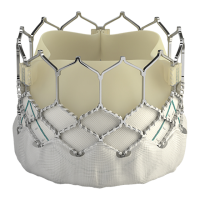11
Step Procedure
7
Disengage the Balloon Lock and retract the tip of the Flex Catheter to the center of the Triple Marker.
Engage the Balloon Lock.
8 Verify the correct position of the valve with respect to the aortic annulus.
9
As necessary, utilize the Flex Wheel to adjust the co-axiality of the valve and the Fine Adjustment
Wheel to adjust the position of the valve.
10
Before deployment, ensure that the valve is correctly positioned between the Valve Alignment
Markers and the Flex Catheter tip is over the Triple Marker.
11
Begin valve deployment:
• Unlock the Inflation device provided by Edwards Lifesciences.
• Begin rapid pacing; once systolic
blood pressure has decreased to 50 mmHg or below, balloon
inflation can commence.
• Deploy the valve by inflating the balloon with the entire volume in the Inflation device provided by
Edwards Lifesciences, hold for 3 seconds and confirm that the barrel of the inflation device is
empty to ensure complete inflation of the balloon.
• Deflate the balloon. When the balloon catheter has been completely deflated, turn off the
pacemaker.
7.3.4 System Removal
Step Procedure
1
Unflex the delivery system while retracting the device, if needed. Verify that the Flex Catheter tip is
locked over the Triple Marker and remove the delivery system from the sheath.
CAUTION: Patient injury could occur if the delivery system is not unflexed prior to removal.
2
Remove all devices when the ACT level is appropriate. Refer to the Edwards eSheath Introducer Set
instructions for use for device removal.
3
Close the access site.
8.0 How Supplied
STERILE: The valve is supplied sterilized with glutaraldehyde solution. The delivery system is supplied
sterilized with ethylene oxide gas.
8.1 Storage
The valve must be stored at 10 °C to 25 °C (50 °F to 77 °F). Each jar is shipped in an enclosure
containing a temperature indicator to detect exposure of the valve to extreme temperature.
The delivery system should be stored in a cool, dry place.
9.0 MR Safety
MR Conditional
Non-clinical testing has demonstrated that the Edwards SAPIEN 3 transcatheter heart valve is MR
Conditional. A patient with this device can be scanned safely, immediately after placement of this device
under the following conditions:
• Static magnetic field of 1.5 tesla or 3 tesla
• Maximum spatial gradient field of 2500 gauss/cm (25 T/m) or less
• Maximum MR system reported, whole body averaged specific absorption rate (SAR) of 2 W/kg
(Normal Operating Mode)
Under the scan conditions defined above, the SAPIEN 3 transcatheter heart valve is expected to produce
a maximum temperature rise of 3.0 ºC after 15 minutes of continuous scanning.

